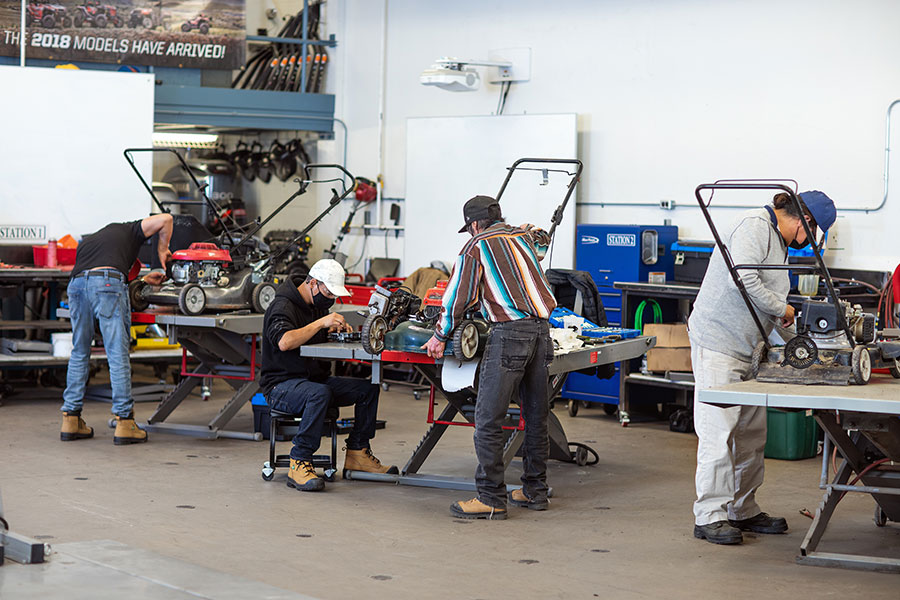Slowly but surely, life returns to campus
NAIT never quit during the pandemic. Instructors kept teaching, students kept learning, executives kept leading and staff ensured that – regardless of the challenges of COVID-19 – the myriad moving parts kept moving. It has been a herculean effort.
But for anyone who might have seen campus over the last year-and-a-half, that effort could have been overlooked. Other than a few staff and students on site at any given time, operations were largely virtual.
This fall marked a change. On Sept. 7, the 2021-22 academic year began, bringing with it roughly 7,700 people a week, including students and staff. It's a fraction of what could have been expected were it not for the coronovirus, but it's a 31% increase from fall 2020, when campus would see just 5,900 per week.
"It was nice to be back on campus and see friendly faces," says staff photographer Leigh Kovesy (Photographic Technology ’01), who captured images of students and staff throughout September.
"Campus was the busiest I've seen since last March. I've missed interacting with people here."
Here's a look through Kovesy's lens at the first month back at NAIT for students and staff, all of whom have returned with an eye on the future, and plans to keep moving toward it.
Busiest since last March

There aren't as many students on campus as usual, but it's still import to make them feel welcome – a job that the NAIT Students' Association took on just as it would under normal circumstances.
"Students not only want quality services on campus, they also want safe and fun opportunities to spend time with their friends and meet new friends," says Jason Roth, NAITSA advocacy director. "Hence the Ookslife outreach booth," he adds, to help make students aware of all that campus has to offer.

Throughout the pandemic, the health and safety of students and staff have remained a priority for the polytechnic. "NAIT has a dedicated team of people who have worked diligently to ensure guidance and protocols on campus reflect the most current information provided by Alberta Health Services and the Alberta Government," says Laura Kavich (Occupational Health and Safety '10), safety consultant.
Many of the practices developed during the last year-and-a-half are still in place, and have kept the risk of on-campus transmission low.

Foot traffic is down at shop at NAIT, NAIT's bookstore, says retail and ancillary services manager Kimmarie Allen, but that does not mean overall activity is too.
"Our service options now include online orders for pickup, delivery or curbside pickup, usually with 24 hours or less of placing the order," she says. "About 50% of students took advantage of this." An added benefit, Allen adds, has been faster service and no long lineups.

Students practising land surveying skills continued to be a common sight in NAIT's quad, directly southeast of the Feltham Centre. Kovesy passed by groups at work most mornings she was on campus in September, providing her with a small sense of routine at a time when routine can seem hard to come by.

Some staff continue as virtual denizens of NAIT, instructing and administrating from home. The onset of the fourth wave of the pandemic is not the only reason. As the pandemic progressed, the need for future flexibility became clear among students. In 2021, preference for in-person learning decreased by 18%, while the preference for online learning increased 14%.
Cybersecurity program chair John Zabiuk turned a spare room at home into "a broadcast studio," with tools and equipment used by professional streamers. He's teaching in-person labs and online lectures. "All of my online sessions are live," Zabiuk says. "Nothing is pre-recorded. Part of what students deserve in class is the ability to interact with the instructor in real-time."

Zabiuk will also make use of NAIT's new HyFlex classroom, now under development. The space and technology will allow students to attend class in person and online, alongside one another. "The two groups interact with each other as if they were in the same room," Zabiuk says. "Although this is new approach to delivery, it has great promise."

Classes that can't be delivered online carry on safely in on-campus shops and labs. Ten students from Louis Bull Tribe First Nation recently completed five weeks of theory and shop instruction in small engine repair on site through NAIT's department of Corporate and Continuing Education.

This summer, NAIT campus safety improved, as protective services hired security agents to free up peace officers to respond to higher-priority calls.
“Many of the calls that we received and responded to were related more to physical security, such as access requests, Safe Walk requests, proactive patrols and campus lockups – duties that could be completed by a security agent rather than a peace officer," says Inspector Anthony Kimakowich of NAIT Protective Services.
The hybrid model is similar to what's used at other post-secondary institutions, including the University of Alberta, MacEwan University and SAIT.

Masks are required in all indoor spaces at NAIT to help protect the health and safety of students and staff, a measure that aligns with guidelines from the provincial government. In addition, the polytechnic recently announced a coming requirement to be fully vaccinated and to provide proof of vaccination to come to campus.
“Given the current status of the pandemic – and our ongoing commitment to the well-being of the NAIT community – this is the most prudent decision we can make at this time,” says Laura Jo Gunter, NAIT president and CEO.

In some ways, the most ordinary scenes are among the most welcome and reassuring. The tables are a little farther apart, but there are still comfortable places to sit and review notes over lunch before the next class. That is, many things continue at NAIT exactly as they should.
"There are students studying everywhere," says Kovesy.